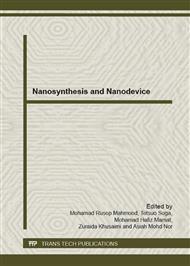p.421
p.425
p.435
p.442
p.447
p.452
p.458
p.464
p.468
Characterization of Copper (I) Iodide (CuI) Thin Film using TMED for Dye-Sensitized Solar Cells
Abstract:
Solid state dye-sensitized solar cells (DSSCs) were first reported in 1991 without employing p-type as hole conductor. The p-type as hole conductor was first introduced in 1995 and CuI is preferred among others p-type semiconductors. However, in 2003 utilizing of CuI based DSSC was found unstable by the excessive iodine strongly decreased the photocurrent of the cell. Later then, the stability of CuI based DSSCs was reported can be improved by added small amount of triethylamine hydrothiocyanate (THT) in the CuI coating solution. Following to that, in this work new chemical is introduce as an option to present situation which can give equally or better effective for fabrication of solid-state DSSCs. The chemical is called tetramethylethylenediamine (TMED), is employed to CuI in sol-gel process and their characterizations have been studied. The CuI coating solution was prepared by dissolved CuI powder with acetonitrile and added in 0.5mL TMED. Using spin coating technique the sol then deposited onto glass and silicon substrate at room temperature. The film were analyzed by their particles conductivity using pH meter, surface morphology using Field Emission Scanning Electron Microscope (FE-SEM) and optical properties using ultraviolet visible spectroscopy (UV-Vis) and photoluminescence (PL) measurement. The results of this sol-gel were compared with other CuI sol-gel which prepared by dissolved CuI powder with acetonitrile only. The optical transmittance within ultra-violet range exhibited that thin film is transparent and it optical band gap have been studied. Further clarification and measurements need to be done in order to prove that the proposed chemical can be used as an option.
Info:
Periodical:
Pages:
447-451
Citation:
Online since:
March 2013
Authors:
Price:
Сopyright:
© 2013 Trans Tech Publications Ltd. All Rights Reserved
Share:
Citation:



